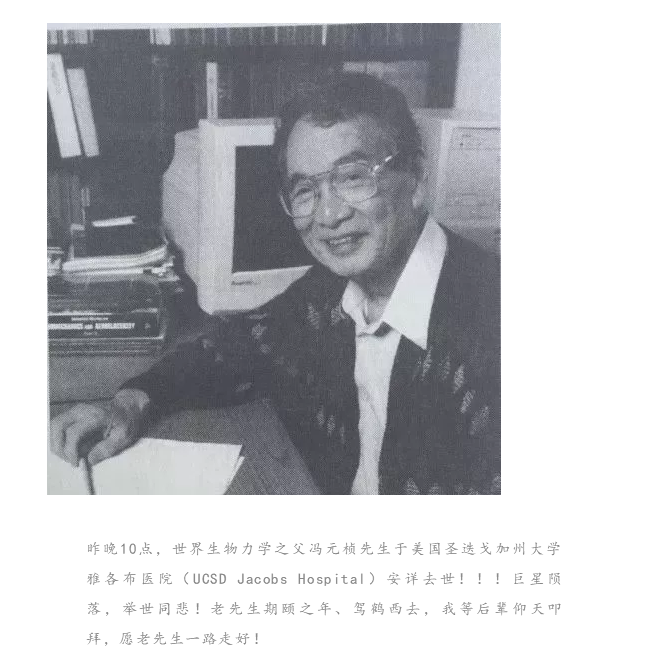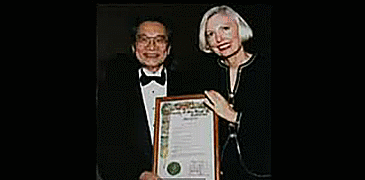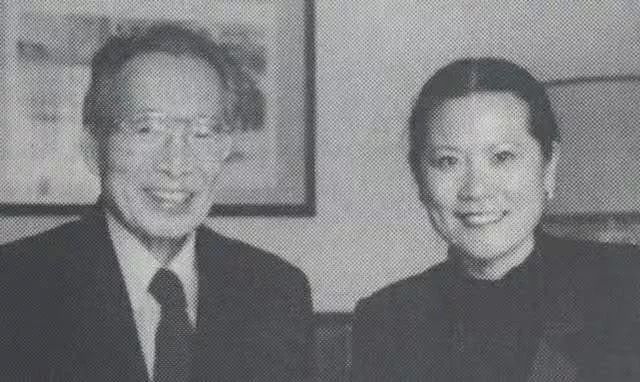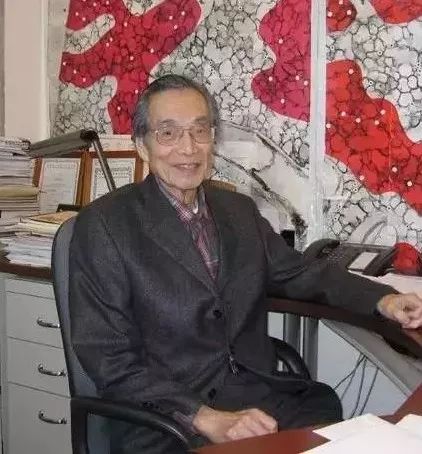博文
[转载]冯老昨日安详离世,生物力学光芒永存
||
冯老昨日安详离世,生物力学光芒永存

冯元桢1919年生于江苏,美籍华人,国际知名力学家,生物力学开创者及奠基人,有“生物力学之父”美誉。美国国家科学院院士、美国国家工程院院士、美国国家医学院院士、中国科学院外籍院士、中国工程院外籍院士及台湾“中央研究院”院士。1992年,获得Timoshenko奖;2000年获美国科学最高荣誉“美国国家科学奖章”,为获此殊荣首位生物工程学家;2007年获得“拉斯奖”(Russ prize),以表彰他“鉴别与确定人体组织的结构与功能,使之有助于创伤的预防及减轻”的贡献。

冯元桢1937年考入中央大学航空系,1941年获学士学位并留校任教,同时攻读研究生,1943年毕业获硕士学位。于1948年获美国加州理工学院博士学位,毕业后留校任教,从事空气动力学、超音速、弹性力学的教学与科学研究,在非线性结构动力学、结构稳定性理论、颤振和冲击响应等方面的研究成果卓著,多次获奖。
之后因为身在国内的母亲生病,他“希望自己在母亲生病的时候能提供一些正确的建议给她”,于是开始转而研究生理学。

20世纪60年代初,冯元桢教授致力于新兴交叉领域——生物力学的开拓,当时生物工程学研究尚处于萌芽阶段,冯元桢在其夫人——名医喻娴士教授的鼓励和支持下从动物解剖开始, 研究活组织、器官的生理和力学机理, 为生物力学开创道路。之后,他在发现人体血球、血管、微循环的奥秘方面取得重大突破,创立了著名的“冯氏隧道理论”。

1966 年,冯元桢教授在美国加州大学圣地亚哥分校创立生物工程系,并将工程学的原理运用于人体机能的研究,在这一领域内,冯元桢和他的实验室取得了三个具有里程碑性质的成就:生物软组织本构关系的研究;.以肺毛细血流片层流动(Sheet flow)模型为核心的肺血流动力学规律的研究;生物组织器官生长和应力的关系的研究。在冯元桢教授的领导下,加大圣地亚哥分校的生物工程研究与教学声名卓著、成果丰硕,并为开创新的医学疗法和增进人类健康建树良多,从而赢得了国际公认的领导地位。
沉痛悼念之际,我们选编了冯老摘获应用力学界最高奖项——“铁木辛科奖章”(Timoshenko Medal)时的获奖致辞,谨盼可以略略追慕先生风采。 First of all, let me thank those of you who worked hard to give me this honor. I know how much effort was involved. I want to thank Dr. Saric, Dr. Bogy, and all the Committee members who indulged in me. And thank you all here this evening. To Chia Shun's remarks I am speechless. I love him as a brother. I am proud to be praised by a sibling. He is the Timoshenko Professor at the University of Michigan. With this medal I can catch up with him to honor our hero. I am very glad to be given this Award, because Timoshenko is my hero. His books on Elasticity, Elastic Stability, and Plates and Shells are the ones I cut my teeth on. Another hero of mine is Theodor von Karman. A third one is Poiseuille, who brought fluid mechanics to medicine. They are my idols, and I am very fortunate to have been given a von Karman medal by ASCE in 1976, a Poiseuille medal by the International Society of Biorheology in 1986, and a Timoshenko medal today. I would like to speak about them. I think they have a common feature in that they developed a mechanics of man, as distinguished from a mechanics of the heaven and earth. In character, these three men were different. Timoshenko had a father image and is more immitigable. In the first lecture I heard from Timoshenko in 1949, he talked about how brilliant St. Venant was in science and engineering. He questioned why St. Venant was so obscure in French history. He searched for the reasons long and detailed. I felt it was like listening to a tale about a lost uncle on Christmas Eve. Another good description of Timoshenko I heard from Den Hartog in his Timoshenko Award acceptance speech. Den Hartog said that he was working under Timoshenko at Westinghouse Research Lab when he finished a paper on torsion and hesitated to publish it because he did not know whether it was important enough. Timoshenko told him, "Who do you think you are! One contributes what one can!" One contributes what one can! I like that attitude. In a von Karman lecture I heard, he opened with a remark about himself. He said that in his youth he missed inventing the radio, in his prime age he missed inventing the airplane, in his senior years he missed inventing the nuclear reactor. In his old age he would miss the exploration of space. So he can only talk about waves, aerodynamics, and aerothermo-dynamics. As a graduate student I did not know what to make of that comment, but I remembered it. It does make sense to me now against his total contributions and ambitions. The story of his inventing the vortex street was this: He was in Gottingen and talked to Herr Hiemenz who had spent years measuring the flow behind a circular cylinder. Hiemenz could not get the flow to be stabilized. The data he obtained was always oscillating. So Karman went to work on it and wrote out the whole theory in one weekend. When he presented it at a meeting in Paris, Henri Benard said that he had photographed the vortices earlier and there were some differences between Karman's theory and the experimental results. Karman made some quick calculations on the back of an envelope, stood up to explain the differences, and suggested that the street should be called "Boulevard de Benard in Paris." Such stories make Karman inimitable. Poiseuille was born in 1797. He attended Ecole Polytechnique and got his Doctor of Science degree at age 31 with a thesis on the measurement of blood pressure with a small bore mercury manometer. He obtained the first accurate values of blood pressure since Stephen Hales showed the way 119 years earlier (1709). Then, in 1840, at an age of 43, he published his famous paper on water flow in circular cylindrical tubes. He used pipettes of diameter 15 microns to avoid turbulence, a diameter similar to capillary blood vessels. After that he published only one other paper, on the measurement of flow with ether and mercury at the suggestion of the reviewers of his famous paper. His biographers did not know what positions he held in his life until he was 63 years old, when he became an inspector of primary schools in Paris. He died on Dec. 26, 1869 at an age of 72. He exemplifies the case that one paper makes a man. These three men are not shy in applying mechanics to new areas. They showed that science is developed by man, and man is helped by developments in science. In hard times like this year of budget cuts, it is worth remembering this principle, because society always has a need to improve the lot of people, and engineers are the ones to deliver such improvements. And the society will always provide the needed resources. I believe in this principle, and did not find too much conflict between personal interest and the necessity for survival. Let me tell you a little bit about myself. I was born in China in 1919. I grew up in a period when China was very unsure of itself. My memory of my childhood was that the Christmas seasons were the time to seek refuge in the countryside, to get out of the way of the war paths of local war lords fighting for territory. I remember my family crowded in a little boat eating cold chicken. That's probably why I have liked cold chicken all my life. Later, China's problem of survival became even more difficult. In my first junior high school year, Japan took Manchuria (the September 18th event). The next year Japan invaded Shanghai (the January 28th event) and we fled to Peking. At year's end, Japan invaded She-Feng Kou and we fled back to Changchow. Students struck often to protest the government's nonresistance policy. I entered college in 1937 when the Japanese militarists started the last big push to conquer China. I chose to study aeronautics because airplanes were needed most in China's fight for survival. In 1943, a consortium of American universities offered 20 graduate assistantships to China. The Chinese government held a national examination, selected the candidates, trained them for language, then sent them on their way. I got the position from Caltech. When I arrived in Pasadena and reported to Ernie Sechler on Jan. 6, 1946, Ernie laughed heartily by saying that the assistantship offer had expired by over two years! But he hired me as an RA. I inherited a little wind tunnel built by von Karman and Louis Dunn to study the flutter of the Tacoma Narrows suspension bridge, and was also given the job to study a drawer full of notes and scratch papers written by Tony Biot on theoretical analysis of flutter of that bridge, and to write a report about it. That was how I got into aeroelasticity. Unfortunately, von Karman had retired, Biot had gone to New York, and Dunn had gone to the Jet Propulsion Laboratory. I was left without a supervisor on aeroelasticity. Professor of mathematics Aristotle Michal took me under his wing. He taught me Frechet derivatives, with which I began my thesis on airplane dynamics. I got my Ph.D. in Aeronautics in 1948, and stayed on the faculty. Ernie Sechler was my mentor. I have an enormous love and respect for him. Whatever I did he could show me a way to make it simpler. He was a wise counselor, and a warm friend. We worked together for 20 years on swept wing design, shell buckling, ICBM base hardening, rocket structure, fuel sloshing, etc. In 1957, I began my self-study of physiology. I had a sabbatical leave in Gottingen, Germany. I stayed at Prandtl and von Karman's old Institution. I found its work on aeroelasticity rather dull, but the library on physiology next door was excellent. The causal factor for my going to the library was my mother's glaucoma. I translated newly published articles on glaucoma into Chinese and sent them to her in China to give to her surgeon. On returning to Caltech I began working on physiology with Sid Sobin, Wally Frasher, and Ben Zweifach. Together we wrote papers on the capillary blood vessels, red blood cells, the interaction of cells and vessels, and the mechanical properties of living soft tissues. I found continuum mechanics indispensible in clarifying these topics. In 1966, I resigned from Caltech and went to UCSD to devote full time to physiology and bioengineering. I wanted to demonstrate that physiological problems can be solved with engineering methods. Together with Sid Sobin, I chose to work on the blood circulation in the lung. It was surprising that a thorough search of literature yielded very little reliable basic data on the pulmonary vasculature. The basic information we needed on the anatomy of the lung and biorheological properties of the materials did not exist. We had to obtain them by ourselves. Hence we had to turn ourselves into anatomists and histologists before we could use mathematical tools for physiology. The program was straightforward, but the road was long. For pulmonary circulation, it took us 12 years before we could close the first round. But we had fun on the way, and found many pretty pebbles right and left. The data we collected can be used to solve other problems. The theory worked out can be used clinically. Our patience was pretty good because a master plan existed and we knew the value of every link in the chain. But the importance of longevity became evident. On approaching retirement, I entered another field: that of the relationship between tissue growth and physical stress. The question began at home. My wife, Luna, has a little high blood pressure which can be controlled with diazyde. But she does not like to take medicine. So she takes diazyde until her blood pressure lowers, then she stops to wait until the blood pressure rises again before taking another pill. This is not what the doctor ordered, and I wanted to know if it was a good idea. So I made a research project out of it. The project turned out to be full of surprises. For example, I found that our blood vessels remodel themselves rather quickly when the blood pressure changes. If the blood pressure was raised as a step function of time, structural change in the blood vessel wall will be detectable in one or two hours. Generally, the inner wall of the blood vessel will thicken first, doubling its thickness in two or three days. Then the outer wall thickens, and can be doubled in about 10 days. Furthermore, the residual stress in the vessel wall changes. Residual stress can be revealed by cutting a vessel segment into a ring, then cutting the ring open radially. The ring opens into a sector. The opening angles of normal arteries vary from place to place in the range of 0 to 90°, but in the aortic arch region it could be about 180°. In the pulmonary trunk it can be 360° or larger, i.e., it has so much residual stress that if it were given a chance to reach zero-stress, the vessel will turn itself inside out! Isn't that amazing! With a stepwise increase of blood pressure, the opening angle will increase first, reach a peak in 2 days, then decrease to an asymptotic value. The up and down swing of opening angle can be as large as 90-100° in some places. Our blood vessels are that alive! Associated with the structural changes, the mechanical properties change also. The constitutive equation changes with time. They are not constitutional laws at all. These results are published in refereed medical journals such as Circulation Research, Journal of Applied Physiology, American Journal of Physiology, Journal of Biomechanical Engineering, etc., so I am not just telling you stories. You understand the mechanics instantly. I wish the medical people were as easily convinced as you are. Fortunately, when the blood pressure is returned to normal, the changes are reversible to a large extent. Hence it appears that my wife is right. So she said, "All right. Then why don't you stop here? Why do you still talk about generalization, and more experiments? Why do you have to have a stress-growth law as you call it, sort of a constitutive equation squared?" I offered Poiseuille as my excuse. I said, "Poiseuille knew that his paper No. 5 is his best. I still think that my next paper will be a better one. I am still experiencing my normal experience. My normal experience is something like this: A problem arises. It looks difficult. It is impossible to crack. I work on it day after day. I draw a blank. Then suddenly it becomes clear. It becomes simpler. Soon it is so simple that it is indeed trivial. I wonder why I did not see it before. So I throw the scratch paper into the waste paper basket. But the experience is pleasant. I call it life's little pleasure. I am still getting these little pleasures. But although the big one has not come, I like the little ones. That's the secret of my life I want to share with you. Now I will conclude with sincere thanks to the Applied Mechanics Division for this heartwarming recognition from colleagues and friends. Thank you all, I wish you all the best. 终其一生,这位“生物力学之父”只信仰一个教条: 听从自己内心的声音,永不放弃对未知的探索,生命不息,奋斗不止。
本文来源连接:https://mp.weixin.qq.com/s/W1Ml4Mh2cSxf3ZBT99DUFQ
https://blog.sciencenet.cn/blog-2374-1210508.html
上一篇:虚实互动的平行城市:基本框架、方法与应用
下一篇:[转载]IEEE TCSS 第6卷6期网刊已发布, 敬请关注!